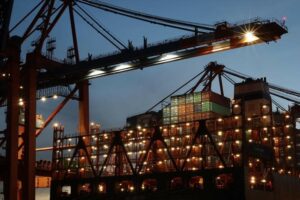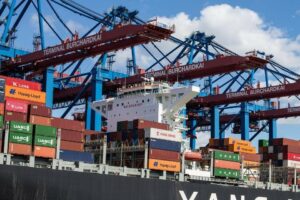There is a continuous evolution in the structure of the shipping market, and during the past 20 years, the rapid growth of maritime trade is resulting in increased numbers of ports, terminals, and container ships. This increase in traffic and goods has put a strain on timely loading and unloading across the globe.
For any business to be profitable, it is essential they are working at peak efficiency. This is especially important in shipping ports where delays result in lost revenue to the port authority, shipping companies, and destination retailers. Additionally, with so many ships waiting to call in at ports, inefficiency delays also create a bottleneck that culminates in the congestion of maritime shipping lanes.
What’s the hold-up?
Regardless of where in the world a shipping port is located, they all have the same facilities, functions, and four variable elements which determine how efficient they are overall. It is these four variables separating the ultra-efficient from the stragglers falling farther and farther behind.
Berth
The longer, wider, and deeper each berth is, the larger the ships that can call into port. If one gigantic vessel can hold the container equivalent of 10 smaller ones, port congestion is reduced, and outgoing unloaded cargo moves at a much quicker pace.
Handling capacity
Handling capacity for shipping ports is measured in metric tons. Obviously, the greater the tonnage a port can handle, the more incoming and outgoing freight will increase.
Storage (TEUs)
Storage is measured by TEU or a 20-foot equivalent unit. As in handling capacity, the more room a port has for storage, the higher the productivity.
Total terminal area
The total terminal area is measured in square feet and encompasses the entire facility. Larger terminals can efficiently handle increased numbers of ships and trucks for transport off the perimeter.
Additionally, efficiency and productivity are affected by three exogenous factors: trading volume, operator type, and terminal type.
Trading volume is determined solely by the demand for services which the port offers; more goods being shipped plus more ships using international shipping lanes equals a larger trading volume.
There are two operator types: local and global. Local operators may not have the large traffic numbers claimed by global operators, simply based on demand and location. For example, a local port in a coastal town of 10,000 people would not see the same demand for their services as one which serves 100,000 people, unless the local port had direct access to other main shipping transportation methods.
Terminals are divided into two types: multi-purpose and container-only. Multi-purpose terminals have no set primary function, but handle everything from bulk, reefer, general cargo, containers, and both Ro-Ro (roll-on roll-off) and Lo-Lo (lift-on lift-off) vessels. Container-only terminals mainly handle Lo-Lo cargo only.
While looking for ways to quickly move cargo and containers ships in and out of port without compromising the integrity of safety and security protocols, new methods are now making it easier than ever to obtain their objectives and remain competitive. These enhanced efficiency ideas may be just what you are looking for to up your port’s productivity!
-
Folding containers
One problem long plaguing shipping ports across the world is the large number of empty cargo containers remaining in port after unloading. Not only do they take up space, but they also diminish profits by occupying prime real estate. The answer to this dilemma may just be folding containers.
Currently manufactured by Staxxon, these innovative alternatives for standard containers take up only a fifth of the space, as compared to non-folding ones. This reaps the rewards of higher overall profits because less time and money will be spent on moving and storing intermodal containers.
-
Autonomous ships
Although this technology is in the pilot project stages, the race to design and utilize self-driving cargo ships is on. Rolls-Royce and Kongsberg are just two of the contenders intending to cross the finish line.
While RR’s plans involve large cargo ships capable of trans-oceanic trade, Kongsberg plans on a smaller design named Hrönn. The utility ship will have a variety of uses, including delivering cargo from ports to installations offshore, support for open-water fish-farming activities, surveying, and the recovery and launching of AUV and ROVs, among others.
With the push towards faster and better, the advantages of using autonomous vessels are obvious in the scope of increased efficiency. They will cost far less to operate, free workers to complete other duties, quickly move in and out of port, and require less inspection time overall.
-
Advanced wireless technology
The potential for radiation and radiological materials to enter ports is a grave security concern. Currently, this means every container needs to be scanned for any suspicious materials, and an alarm will sound when there is a concern.
However, radiation does naturally occur, and even in minute levels, it can set off radiation alarms. These false “positives” waste time and money as inspectors must investigate further to determine if there is any cause for alarm.
With a new app for smartphones released by the IAEA, this drain on manpower and resources may be a thing of the past. The intelligent app could help distinguish between the alarms, giving inspectors the green light to pass containers with levels of radiation from naturally occurring sources.
When the app detects that there is a true threat, it communicates the need for closer inspection. Once this is put into use at participating ports, there is a huge decrease in wait time for loading, unloading, and storage clearances.
-
Enhanced automation
It is massively time-consuming to carry out inspections of cargo, containers, and ships. The sheer size of container ships means an entire security inspection team could easily spend a full day discovering all the hidden nooks and crannies built into a ship’s design. While this is often an exercise in futility and hugely inefficient, they do find prohibited materials in some instances.
The trend towards automation is no longer just for drones and robots in industrial applications. The Conley Container Terminal in Boston is the latest stop for automation at its finest. Their massive cargo inspection facility is completely geared towards hands-off detection.
The revolutionary technology system features 3D imaging and can identify, locate, and detect prohibited cargo. The increase in efficiency will become apparent immediately as SmartScan, the brainchild of Passport Systems, Inc., and will also automatically authorize alarms requiring human intervention and clear the ones it deems to be harmless.
Final thoughts
As the demand for consumer goods increases, so too will the maritime traffic at shipping ports around the globe. The key to making sure the supply chain remains uninterrupted is the implementation of measures and advances, which increase the efficiency with which goods move in and out of ports.
The faster each ship is examined and loaded or unloaded, the quicker that materials reach the end consumer and allow for increased turnover rates in container ships. Some of the world’s busiest seaports are setting a standard that the rest of the industry needs to catch up with. As time goes on, there will be the unveiling of newer methods, technologies, and equipment that will have us looking back on today’s shipping structure the same way we now view “snail mail,” and no port serious about the business of effectiveness and efficiency will want to be left behind.








